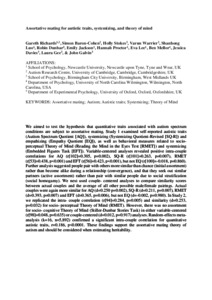Richards, Gareth and Baron-Cohen, Simon and Stokes, Holly and Warrier, Varun and Shanhong, Luo and Dunbar, Robin and Jackson, Emily and Proctor, Hannah and Lee, Eva and Mellor, Ben and Davies, Jessica and Gee, Laura and Galvin, John
(2021)
Behavior Genetics Association 51st Annual Meeting Abstracts; Assortative mating for autistic traits, systemizing, and theory of mind.
Behavior Genetics, 51.
p. 736.
ISSN 1573-3297
![[img]](/11890/1.hassmallThumbnailVersion/Richards%20et%20al.%20Behavior%20Genetics.pdf)  Preview |
|
Text
Richards et al. Behavior Genetics.pdf
- Accepted Version
Download (185kB)
|
Abstract
We aimed to test the hypothesis that quantitative traits associated with autism spectrum conditions are subject to assortative mating. Study 1 examined self-reported autistic traits (Autism Spectrum Quotient [AQ]), systemizing (Systemizing Quotient-Revised [SQ-R]) and empathizing (Empathy Quotient [EQ]), as well as behavioral measures related to socio-perceptual Theory of Mind (Reading the Mind in the Eyes Test [RMET]) and systemizing (Embedded Figures Task [EFT]). Variable-centered analyses revealed positive intra-couple correlations for AQ (r[102]=0.305, p=0.002), SQ-R (r[101]=0.263, p=0.007), RMET (r[53]=0.438, p<0.001) and EFT (r[56]=0.423, p<0.001), but not EQ (r[100]=-0.018, p=0.860). Further analysis suggested people pair with others more similar than chance (initial assortment) rather than become alike during a relationship (convergence), and that they seek out similar partners (active assortment) rather than pair with similar people due to social stratification (social homogamy). We next used couple- centered analyses to compare similarity scores between actual couples and the average of all other possible male/female pairings. Actual couples were again more similar for AQ (d=0.250 p=0.002), SQ-R (d=0.211, p=0.007), RMET (d=0.393, p=0.007) and EFT (d=0.365, p=0.006), but not EQ (d=-0.002, p=0.980). In Study 2, we replicated the intra- couple correlation (r[94]=0.284, p=0.005) and similarity (d=0.253, p=0.032) for socio- perceptual Theory of Mind (RMET). However, there was no assortment for socio- cognitive Theory of Mind (Stiller-Dunbar Stories Task) in either variable-centered (r[98]=0.048, p=0.635) or couple-centered (d=0.012, p=0.917) analyses. Random-effects meta-analysis (k=16, n=5,892) confirmed a significant intra-couple correlation for quantitative autistic traits, r=0.186, p<0.0001. These findings support the assortative mating theory of autism and should be considered when estimating heritability.
Actions (login required)
 |
View Item |

 Tools
Tools Tools
Tools